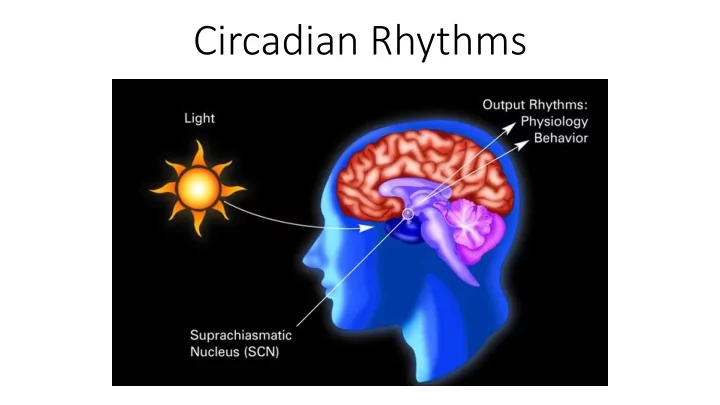

Circadian Rhythms
Controlling the timing of behaviour by anticipating the environment • Circadian = circa + dium • Exists in most if not all unicellular and multicellular organisms
The Circadian Circuit Environmental Output Inputs Rhythms Light Hormonal Cycles Temperature Rest/Wake Social Activity Feeding Central Pacemaker
Health consequences of circadian misalignment Social Jet Lag Shift Work Increased risk of: - Obesity - Diabetes - Cancer - Mental Illness Light at Night Roenneberg et al. (2012) Current Biology
Historical Perspective Jean-Jacques d’Ortous de Mairan (1678 – 1771) Hist de l’Acad Royal Sci (Paris) , 1729 “…Il est seulement un peu moins marqué lorsqu’on la tient toujours enfermée dans un lieu obscur …” “The sensitive plant hence perceives the sun without seeing it” Rhythms in leaf-opening persist even in the absence of sunlight
Historical Perspective Rat Comp Psychol Monographs , 1922 Nathaniel Kleitman (1895 – 1999) Figure 18.4 Sleep and Wakefulness , 1963
Historical Perspective ’Founders of Chronobiology’ 1960 • Conceptual framework of circadian rhythms • Long before any genes or neural circuits were identified Colin Pittendrigh Jürgen Aschoff (1918 – 1996) (1913 – 1998) Cold Spring Harbor Symposium on Quantitative Biology, Vol. XXV Biological Clocks
The Circadian Circuit Environmental Output Inputs Rhythms Light Hormonal Cycles Temperature Rest/Wake Social Activity Feeding Central Pacemaker What would a circadian pacemaker look like?
The Circadian Circuit Environmental Output Inputs Rhythms Light Hormonal Cycles Temperature Rest/Wake Social Activity Feeding Central Pacemaker
The Molecular Clock
Circadian behaviour has a genetic component Drosophila period ( per ) locomotion Ron Konopka & Seymour Benzer Konopka & Benzer, PNAS 68:2112, 1971 eclosion
Identification of the molecular mechanisms controlling circadian rhythms Core clock genes in drosophila
Similar molecular mechanisms generate circadian rhythms in flies and mammals Core clock genes in drosophila Core clock genes in mammals Transcription-translation feedback loop
Deleting the circadian clock causes arrhythmicity • Global Bmal1 KO • Fully deleting any of the 4 key components of the molecular clock causes behavioural arrhythmicity
The core circadian clock genes are expressed throughout the body Expression of Bmal1 However, one area of the brain was particularly enriched in clock genes
The Master Pacemaker
In mammals, the suprachiasmatic nucleus (SCN) is the master circadian pacemaker (Kriegsfeld & Silver, 2006) The SCN is necessary and sufficient for circadian rhythms Guo et al. (2006) J Neurosci
The SCN has self-sustained rhythms in gene expression, firing activity and neurotransmitter release Clock gene expression Neurotransmitter Release Firing Activity Ramkisoensing and Meijer (2015) Front. Neurol.
Individual SCN neurons have circadian oscillations in gene expression driven by the ‘molecular clock’ Core Clock genes create a ~24-h transcription-translation feedback loop PERIOD2::LUCIFERASE Single-cell rhythms in gene expression
The SCN is Composed of Multiple Autonomous Single-Cell Oscillators Single-cell rhythms in spontaneous firing activity 3 5 Frequency (Hz) 0 0 0 24 48 72 0 24 48 72 2 8 0 0 0 24 48 72 0 24 48 72 Mazuski et al. Welsh, Logothetis, Meister, & Reppert, Neuron 14:697, 1995
Self-sustained rhythms is a unique feature of the SCN Yamazaki et al (2009) JBR
In vivo rhythms in firing activity and gene expression Ono, Honma & Honma (2015) Takasu et al. (2013)
Many open questions remain about SCN function • Clock gene expression How neurons in the SCN respond during Neurotransmitter Release different lighting conditions (e.g. seasons) and disease-states (e.g. Alzheimer's) • How individual SCN neurons couple together? • How input information is processed within the SCN • How circadian information is communicated to the rest of the brain Firing Activity Ramkisoensing and Meijer (2015) Front. Neurol.
The Circadian Circuit Environmental Output Inputs Rhythms Light Hormonal Cycles Temperature Rest/Wake Social Activity Feeding Central Pacemaker
Photic Information
Blocking the input pathway to the SCN should result in a free-running organism • Ennucleated mice show free-running circadian rhythms • However, mice that lack both rods and cones show intact circadian rhythms
Melanopsin-expressing intrinsically photosensitive retinal ganglion cells (ipRGCs) are necessary for circadian entrainment
ipRGCs project to the suprachiasmatic nucleus as well as other brain regions
The Circadian Circuit Environmental Output Inputs Rhythms Light Hormonal Cycles Temperature Rest/Wake Social Activity Feeding Central Pacemaker How does the SCN communicate circadian information to the rest of the brain?
SCN largely innervates hypothalamic areas
SCN transplants only partially recover circadian rhythms Meyer-Bernstein et al. (1999) Endocrinology Guo et al. (2006) J Neurosci
Timed firing of SCN can shift circadian rhythms in locomotor activity Mazuski et al
SCN circuits that can modulate other behaviours SCN VIP neurons can regulate the timing of aggression SCN vasopressin neurons can regulate the timing of thirst
Circadian regulation of key behaviours remains unexplained
Many questions remain about how the SCN communicates timing information • Diffusable factor, neuronal communication or both? • What about non-brain areas? • Differences between diurnal/nocturnal animals? • How is timing communicated?
The Circadian Circuit Environmental Output Inputs Rhythms Light Hormonal Cycles Temperature Rest/Wake Social Activity Feeding Central Pacemaker
Recommend
More recommend